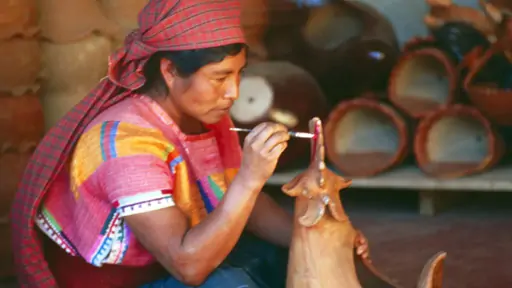Indigenous Calendar January, 2011: Pre-Columbian Tzeltal Pottery

I was in Chiapas State, Mexico, visiting Tzeltal and Tzotzil villages. One village in particular was high on my list of places to visit. Amatenango del Valle is a Tzeltal village of only a few thousand people. It is situated in an area that has been inhabited by the Tzeltal Maya for at least a thousand years — probably longer. It is quite famous today and is mentioned in most guide books covering this part of Mexico.
Amatenango del Valle is worth visiting for many reasons. The modern Tzeltal people who live there are very welcoming and friendly; the village has an impressive church that is around three hundred years old and witnesses a mixture of Maya- and Catholic-influenced practices and the climate is pleasant all year round — the village sits almost two thousand meters above sea level. But what draws people here the most is the practice of making pottery.
Pottery has been made here since the area was first settled thanks to an abundance of local clay. The village is often called the village of clay workers. But the reason Amatenango del Valle is different from many other places where pottery is made is that the techniques have survived from before the Spanish arrived. While this means that the pottery is still made by hand it also means that it is still fired inside a real wood fire instead of a kiln.
The practice would have started in the area out of the necessity to make practical household items like pots for cooking and jars for storing food and water. Traditionally it was Tzeltal women who made this pottery and today also the visitor sees exclusively women making it. However these women have recently begun to understand the commercial value of their niche art form and a significant tourist-oriented trade has developed in the village — making and selling "art pottery" animal figurines. Some Tzeltal women in Amatenango del Valle still make pots and jars but many women make these animal figurines — animales, while young girls in the village make smaller versions — animalitos, as they hone their skills.
As my guide and I approached the turn-off from the main road into the village there was predictably a large display of animales and animalitos from which to make my purchases. Although I intended to buy something, most of my time would be spent wandering through the village itself talking to the inhabitants and, I hoped, seeing pottery being made.
I must have timed my visit unfortunately because we wandered through what seemed like the whole village and saw nobody making pottery. Then as we turned a corner a woman and her young daughter were both busy at work — not shaping or firing but painting their animales and animalitos. They were used to seeing foreigners with cameras but, as always, I sought permission before using mine. In the end I took many photos of the woman and of her daughter. Some of those photos were posed but, as I often find, the best one wasn't.
If you enjoyed reading this article, please consider supporting independent, advertising-free journalism by buying us a coffee to help us cover the cost of hosting our web site. Please click on the link or scan the QR code. Thanks!


